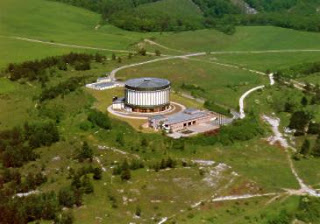The strange mixture of socialist realism with underlying Christian themes found in the Soviet War Memorial in Treptower Park and other monuments in former East Berlin is mirrored truly amazing Panorama Museum in Bad Frankenhausen. Although this site is off the beaten track and rarely visited by tourists other then former East Germans it is well worth visiting.
Planned as a monument to glories of communism, and the triumphs of the German Democratic Republic (DDR), it was built on the site of the last battle of the Peasants War of 1525. The museum took almost twenty years to plan and complete. At its core is a large panoramic painting that depicts world history from the creation to the present.
This was unique work of art planned and executed by the Leipzig artist Werner Tübke (1929-2004) who combined elements of modern art with the style of Martin Luther’s (1483-1546) friend and supporter Lucas Cranach (1472-1553). Eventually, the museum was opened as tribute to the DDR on 14 September, 1989, barely two months before the fall of the Berlin Wall on 9 November 1989, and a year before the DDR was absorbed by the Federal Republic of former West Germany.
This picture depicts the last battle of the Peasant's War in the center is Thomas Münster. Below Münster, standing around a fountain are Martin Luther and a group of his contemporaries. The scene on the left depicts the beginning of modern industry. Below is a close up of Luther.
What is remarkable about Tübke’s art is that these massive paintings follow a Biblical theme. They begin with creation, followed by the Fall, before outlining the course of Western European history. Although the Communist authorities may have wanted to glorify Thomas Münster (1488-1525) and the rebels of the Peasants Revolt, Tübke makes Martin Luther and the Reformation the center piece of his panoramic drama.
Tüpke even takes medieval beliefs about demons seriously while placing great emphasis on the importance of Bible reading and the revolution that the rise of Protestantism initiated. Following theories that are closer to those of the sociologist Max Weber (1864-1920) than Karl Marx (1818-1883) he takes Christianity seriously in a way few modern artists do.
After one enters the museum and pays a very reasonable entrance fee to see the paintings, visitors are given a recorder that plays a commentary in English, German, or French. Then they are allowed into the main hall where they are given ten minutes or so to look around. After that the lights are dimmed and a spotlight systematically highlights different aspects of the paintings while the commentary explains their meaning and relation to history. Once the display is over visitors are allowed to look at the paintings on their own for ten to fifteen minutes before they are asked to leave and another party enters. People who want to stay on and hear the commentary again are allowed to do so. Overall this is a very impressive experience that is not easily forgotten.
The new age of industry and exploration following the Reformation
My thanks go to the staff of the Panorama Museum for giving me permission to reproduce these pictures.
Related websites about the Panorama Museum and the artist Werner Tüpke are to be found at:
Related websites about the Panorama Museum and the artist Werner Tüpke are to be found at:
http://www.panorama-museum.de/html/the_panorama_museum.html
http://tuebke-stiftung-leipzig.de/index.php?lang=english
More to follow …













